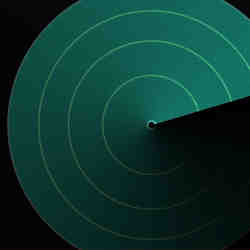
Shabir Barzanjeh and colleagues at the Institute of Science and Technology Austria recently published research that details the creation of a type of quantum radar. Using a technique called quantum illumination, Barzanjeh and team entangled photons to produce a "powerful sensing technique" that can boost the "detection of low-reflectivity objects in environments with bright thermal noise." The result is a quantum radar that can achieve better results than ordinary radar.
The approach uses quantum entanglement at microwave frequencies to produce these results. Quantum entanglement pairs two photons at the quantum level, so when something happens to one photon, researchers can see the same effect in its pair. In the case of quantum radar, two photons are entangled, with one photon considered the "idler" and another considered the "signaler." The signaler photon is fired at a target, while the idler stays with researchers. When the signaler reflects off the object, the change can be observed in the idler.
Because the entangled photons are so similar, filtering out thermal background noise is easier. Often, conventional radars have trouble filtering out thermal background noise, which can be any type of interference from the radar itself or objects around it. The quantum radar described in the paper demonstrates a signal-to-noise ratio up to three times better "compared to the classical benchmark, the coherent-state transmitter, outperforming any classically-correlated radar source at the same signal power and bandwidth," according to the study. The radars typically used for this type of detection are high-energy, too, whereas quantum radar uses very little energy.
"Our work represents the first proof of principle [of] microwave quantum radar, where the quantum enhancement in object detection is fully certified with respect to the optimal performance of a classical radar system," says Barzanjeh. "In other words, we show that quantum entanglement improves the sensitivity of a sensor which outperforms existing classical benchmarks."
Barzanjeh says the research is useful right now for short-range detection; a potential application could be non-invasive medical scanning. Because the radar uses so little power, it may also be able to scan human tissue, proteins, and other fragile biological material without causing damage. The short-range radar technique might also have security applications "in closed and populated environments," according to the research.
The longer-term possibilities of quantum radar, however, are attracting attention in military circles, because they have the power to overcome the limitations of conventional military radar. Today's radar systems aren't always that good at picking up the details of objects being tracked, so militaries must use other technologies to determine whether an airborne object picked up on their conventional radar is a commercial airliner, an enemy fighter jet, or a meteor.
A sufficiently powerful quantum radar, however, could help militaries identify objects accurately on the first pass.
In addition, quantum radar also uses lower levels of radiation, so quantum radar would be harder for adversaries to detect than conventional radar.
"The hope for quantum illumination is that in situations with very low return signal and high background noise (like detecting stealth aircraft), you would gain a quantum advantage in the signal to noise, and therefore detection probability," says Jonathan Baugh, an associate professor at the Institute of Quantum Computing of Canada's University of Waterloo. Baugh also is working on a type of quantum illumination research.
"While some advantage has been demonstrated in laboratory experiments, it remains to be seen whether this can be of practical benefit in real field applications, and there are certainly technical challenges to be overcome," he says.
Barzanjeh also says the technology is not ready for use in military applications just yet.
"It is the proof of principle [of] microwave quantum radar. This cannot be used for the long-range application, instead can be used in short-range object detection, for example," says Barzanjeh. "Our paper is mainly for short-range detection and will not really be useful for defense applications. For us what is important is the scientific part, and especially the relation between [quantum mechanics] and detection efficiency."
Logan Kugler is a freelance technology writer based in Tampa, FL, USA. He has written for over 60 major publications.



Join the Discussion (0)
Become a Member or Sign In to Post a Comment